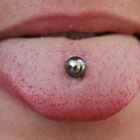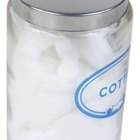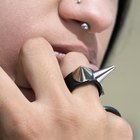Although the discomfort associated with a belly button piercing may be short term, care of the piercing is a long-term commitment. Clean the area gently to cut down on infection risk, and choose your clothing wisely so it won't snag on the piercing. Weigh the responsibility of a belly button piercing against your desire for the glitzy body adornment as you decide whether the piercing is right for you.
Belly Button Piercing Basics
The piercing process uses a hollow needle to create a hole through the skin surrounding your belly button. Then, your belly button ring of choice -- from a hoop or barbell to a pendant or stud -- is placed through the newly created hole. This body adornment has aesthetic advantages, but comes with health risks.
Pros: The Fashion
A belly button piercing, like other forms of body art, allows you to express your style.
A Hint of Sparkle
Piercing your navel is a form of personal expression, and lets you adorn your mid-section in a very personal way. An edgy look calls for a classic hoop or barbell in gold or sterling silver. For a hint of sparkle, a pendant navel ring encrusted with gemstones will draw attention to your tummy.
Easy Concealment
When you don't want it to show, a belly button piercing is easy to conceal compared to other piercings. Unless you're wearing a bikini or crop top, your navel ring won't be visible. Therefore, your piercing won't be a problem in conservative environments such as the workplace, where body jewelry might be frowned upon.
Cons: The Risks
Despite the appeal of sparkling body jewelry, belly button piercings come with disadvantages -- and these can affect your health.
Slow Healing Time
The navel is slow to heal after a piercing, a process which could take from nine months to a year to complete. Careful cleaning of the area during this period is essential to minimize the risk of infection.
Allergic Reactions to Jewelry
While most rings are made of sterling silver, gold, niobium, or titanium, nickel is often added to strengthen and harden the jewelry. The nickel can trigger an allergic reaction, which can show up as a rash, skin swelling, dry patches and blisters.
Infections
Belly button piercings can lead to infections. During the piercing, a less than sterile environment or unsanitized equipment can transmit viruses including hepatitis A and C. Likewise, bacteria like Staphylococcus and Streptococcus can be spread when skin is not properly cleaned. Tight-fitting clothing against the navel can also increase the risk of bacterial infections.
If you have an infection or open wound, delay your belly button piercing until the problem has resolved. An existing abrasion increases your risk of complications during the piercing procedure. Other conditions such as uncontrolled diabetes or immune system deficiencies may up your risk of infection. Talk to your doctor about the risks associated with a belly button piercing, especially if you have one of these conditions.
Related Articles

Nose Hoop Vs. Stud

Reactions to Nose Piercings

Facts on Nose Piercings

Nose Ring Problems

How to Remove a Labret Piercing

Different Body Piercings for Women

How to Prepare for a Nose Piercing

Homemade Recipe to Disinfect a Piercing

How to Clean Nose Rings

How Dangerous Is It to Pierce Your ...

How to Care for a Rook Piercing

List of Body Parts That Can Be Pierced

How to Keep a Piercing From Rejecting

Information on Nose Piercings

What You Need to Know About ...

How Do I Change a Belly Button Ring for ...

How Long Should I Wait to Get My Nose ...

The Disadvantages of a Belly Button Ring

Piercing Ideas for Respectable Women

Male Nipple Piercing Information
References
Writer Bio
Barbie Carpenter worked as a technical writer and editor in the defense industry for six years. She also served as a newspaper feature page editor and nationally syndicated columnist for the Hearst Corp. Carpenter holds a Bachelor of Science in journalism from the University of Florida and a graduate certificate in professional writing from the University of Central Florida.